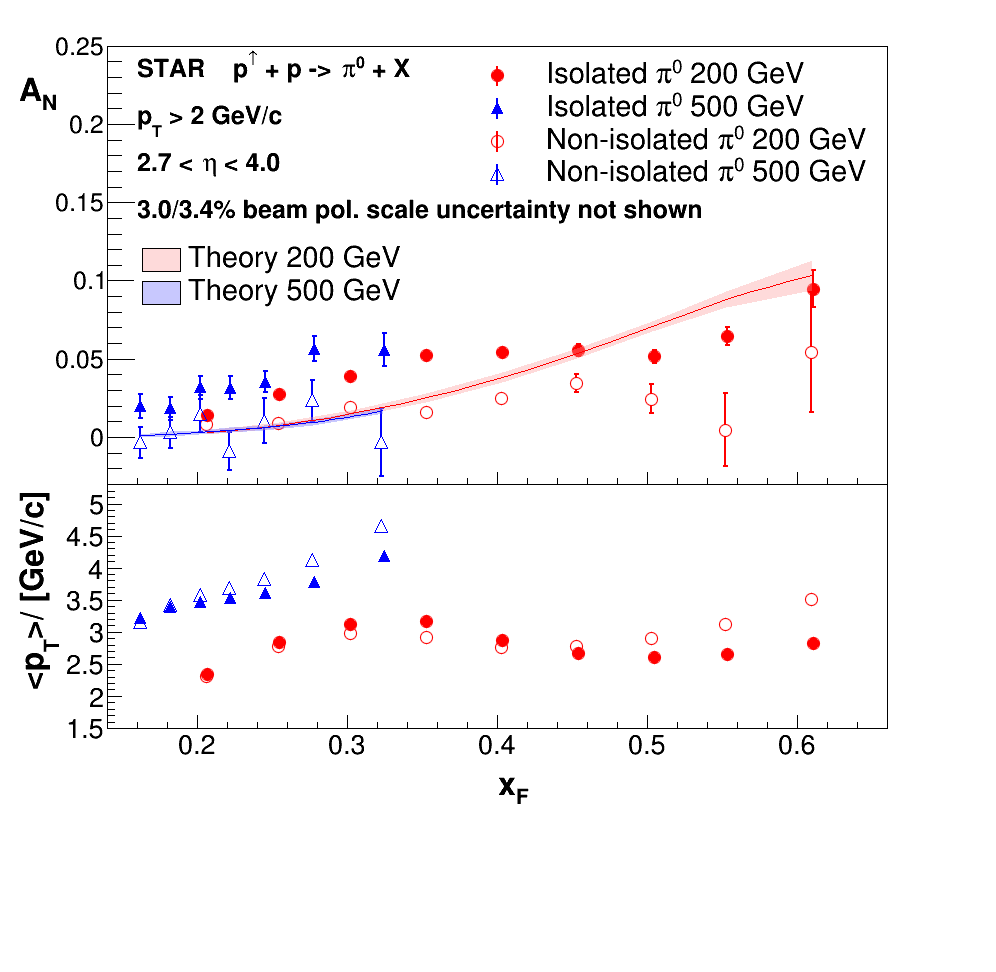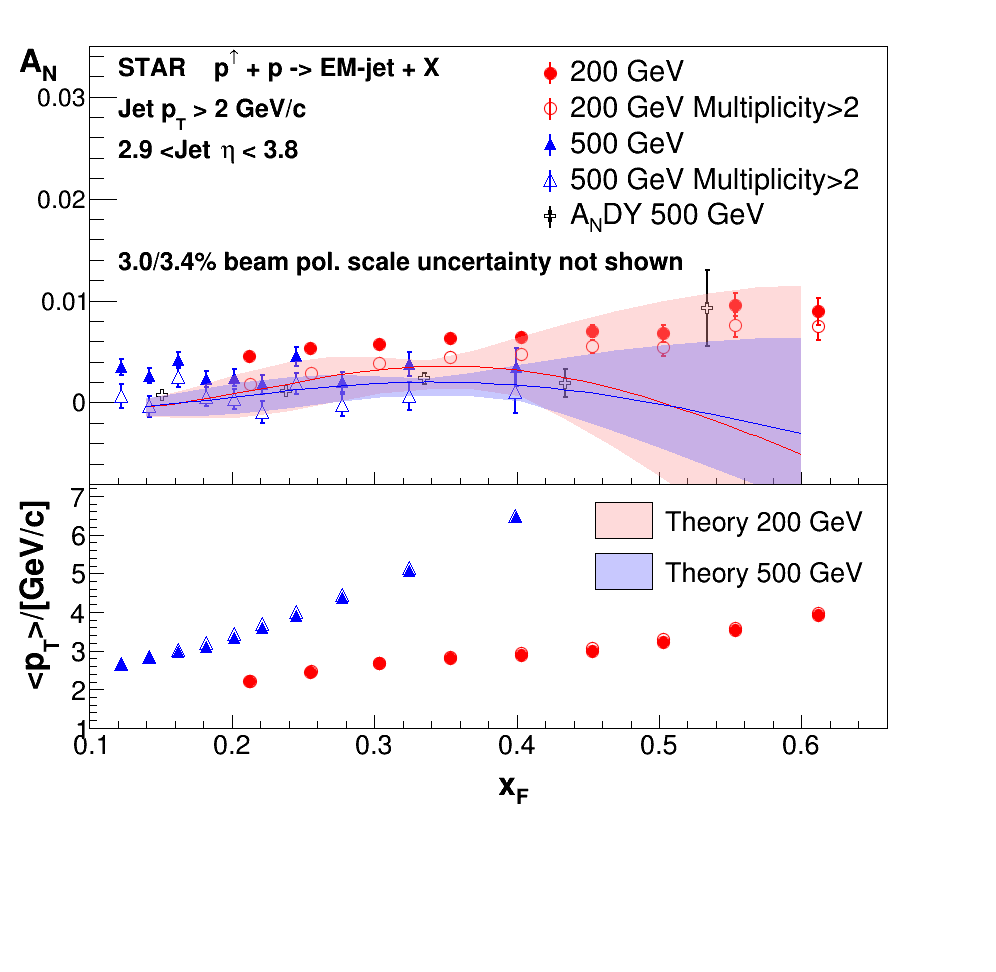FMS pi0 TSSA paper
Updated on Wed, 2020-09-23 00:14. Originally created by zwzhu on 2019-11-17 09:36.
Figures:
Figure1 Example of mass spectrum of the reconstructed $\pi^{0}$ in the FMS with energy between 38 to 43 GeV for transverse single spin asymmetry calculation. The mass spectrum is divided into signal region(0.0-0.2 GeV) and sideband region(0.2-0.3 GeV) which is used in back ground subtraction. The dash lines are fitted result of $\pi^{0}$ signal and background. The solid black line is the combined fitted result
.png)
.png)
.png)
Figure4 The transverse single-spin asymmetry as function of the $\pi^{0}$ transverse momentum for three different Feynman-$x$ ranges for transversely polarized proton-proton collisions at 200 and 500 GeV. Theory curves based on the recent global fit~\cite{Cammarota:2020qcw} are also shown
.png)
.png)
.png)

Figure8 Transverse single spin asymmetry as function of Feynman-x region for electromagnetic jets in polarized p-p collisions at 200 and 500 GeV. The results that requires at least three photons inside a jet are shown as open circles. The previous measurements reported by the $A_{N}DY$ Collaboration are also plotted. The theory curves\cite{jetAN2} for TSSA of the full jets at <y> = 3.25 for 200 GeV and <y> = 3.57 for 500 GeV are drawn upon. The average transverse momentum of the jet for each Feynman-x bin is shown in the lower panel


.png)
Supporting Material Links:
Nov18 spin meeting drupal.star.bnl.gov/STAR/system/files/Changes%20and%20paper%20proposal_0.pdf
Paper proposal:
LAST UPDATE: Dec 6
https://drupal.star.bnl.gov/STAR/system/files/proposal1206.pdf
PWGC presentation on Dec 6
drupal.star.bnl.gov/STAR/system/files/forPWGC.pdf
STAR Note :PSN751
Current Version (updated in 0923) : paper , analysis note
TITLE: Measurement of transverse single spin asymmetry of $\pi^0$ and electromagnetic jet at 200 and 500GeV polarized proton-proton collision at forward direction at STAR
PA: Zhanwen Zhu, Elke Aschenauer, Qinghua Xu and ...
Target journal: PRD
Abstract:
The STAR Collaboration reports measurements of the transverse single-spin asymmetry (TSSA) of inclusive neutral pions at center-of-mass energies of 200 GeV and 500 GeV in transversely polarized proton-proton collisions in the pseudo-rapidity region 2.7 to 4.0. The results at the two different center-of-mass energies show a continuous increase of the TSSA with Feynman-$x$, and comparing with previous measurements, no dependence on the center-of-mass energy from 19.4 GeV to 500 GeV is found. To investigate the underlying physics leading to this large TSSA, different topologies have been studied. Pions with no nearby particles tend to have a higher TSSA than inclusive pions. The TSSA for inclusive electromagnetic jets, sensitive to the Sivers effect in the initial state, is lower, but shows the same behavior as the inclusive $\pi^0$ asymmetry as function of Feynman-$x$. To investigate final state effects, the Collins asymmetry of neutral pions inside electromagnetic jets has been measured. It was found to be small for both center-of-mass energies as function of the transverse momentum and the energy fraction of the $\pi^0$ with respect to the jet axis and energy, respectively. All of the measurements are compared to state of the art theoretical calculations for transverse momentum-dependent parton distribution functions and fragmentation functions.
Concusion:
We report the measurements of transverse single-spin asymmetries for $\pi^0$s in the forward rapidity region in proton-proton collisions at 500 GeV using the FMS at STAR. The same measurement at 200 GeV is done with the highest statistics so far. The asymmetries increase with Feynman-$x$. No energy dependence was found comparing the current results with data previously measured at RHIC and FNAL with center-of mass energies as low as 19.4 GeV.
The transverse single-spin asymmetries for isolated and non-isolated $\pi^0$ at both 200 GeV and 500 GeV are presented. The asymmetries of isolated $\pi^0$s are significantly larger than those of non-isolated $\pi^0$s.
The transverse single-spin asymmetries for electromagnetic jets are measured with the FMS in transversely polarized proton-proton collisions at both 200 GeV and 500 GeV. The 500 GeV result with a minimum photon multiplicity requirement is consistent with zero, which coincides with the full jet measurement from the $A_NDY$ experiment. The 200 GeV results are small but clearly non-zero within uncertainties.
Collins asymmetries for $\pi^0$s within an electromagnetic jet were measured in proton-proton collisions at both 200 GeV and 500 GeV. The asymmetries are small across the $z_{em}$ bins and might exhibit a $j_T$ dependence at 200 GeV.
These new data provide important information for understanding the underlying physics mechanism for the transverse single-spin asymmetry. In particular, the observed small TSSA for non-isolated $\pi^0$s and also small Collins asymmetries with EM jets suggest that the Collins effect itself can not account for the observed $\pi^0$ TSSA.
Figures:
Figure1 Example of mass spectrum of the reconstructed $\pi^{0}$ in the FMS with energy between 38 to 43 GeV for transverse single spin asymmetry calculation. The mass spectrum is divided into signal region(0.0-0.2 GeV) and sideband region(0.2-0.3 GeV) which is used in back ground subtraction. The dash lines are fitted result of $\pi^{0}$ signal and background. The solid black line is the combined fitted result
.png)
Figure2 Electromagnetic jet multiplicity in polarized p-p collision at 200 and 500 GeV .
.png)
Figure3 Transverse single spin asymmetry as function of Feynman-x for $\pi^{0}$ production in transversely polarized p-p collisions at 200 and 500 GeV. The theory curves based on a latest global fit\cite{Cammarota:2020qcw} are drawn upon. The average transverse momentum of the $\pi^{0}$ for each $x_F$ bin is shown in the lower panel
.png)
Figure4 The transverse single-spin asymmetry as function of the $\pi^{0}$ transverse momentum for three different Feynman-$x$ ranges for transversely polarized proton-proton collisions at 200 and 500 GeV. Theory curves based on the recent global fit~\cite{Cammarota:2020qcw} are also shown
.png)
Figure5 Comparison of the transverse single spin asymmetry in positive Feynman-x region for inclusive $\pi^{0}$ with results from previous measurements whose center of mass energies range from 19.4GeV to 200GeV in polarized p-p collision. The average transverse momentum of the $\pi^{0}$ for each $x_F$ bin is shown in the lower panel。
.png)
Figure6 Fractions of isolated and non-isolated $\pi^{0}$ to the overall inclusive $\pi^{0}$ sample in the mass region 0-0.3 GeV, background subtraction being accounted for. The missing fraction includes the events between the isolated cuts: $0.9<z_{em}<0.98$ and the events whose decay photons belong to different jets.
.png)
Figure7 The transverse single spin asymmetry as function of Feynman-x for the isolated and non-isolated $\pi^{0}$ in transversely polarized p-p collisions at 200 and 500 GeV. The theory curves based on a latest global fit\cite{Cammarota:2020qcw} are drawn upon. The average transverse momentum of the $\pi^{0}$ for each $x_F$ bin is shown in the lower panel

Figure8 Transverse single spin asymmetry as function of Feynman-x region for electromagnetic jets in polarized p-p collisions at 200 and 500 GeV. The results that requires at least three photons inside a jet are shown as open circles. The previous measurements reported by the $A_{N}DY$ Collaboration are also plotted. The theory curves\cite{jetAN2} for TSSA of the full jets at <y> = 3.25 for 200 GeV and <y> = 3.57 for 500 GeV are drawn upon. The average transverse momentum of the jet for each Feynman-x bin is shown in the lower panel

Figure9 The Collins asymmetry for $\pi^{0}$ in an electromagnetic jet for transversely polarized p-p collisions at 200 and 500 GeV. The theory curves considering with or without the TMD evolution \cite{Kang:2017btw} for the Collins asymmetry of a $\pi^0$ in a full jet are drawn upon.

Figure10
The $j_T$ dependence of the Collins asymmetry in transversely polarized p-p collisions at 200 GeV..png)
Supporting Material Links:
Pwg meeting:
Jul Collabration meeting
Nov18 spin meeting drupal.star.bnl.gov/STAR/system/files/Changes%20and%20paper%20proposal_0.pdf
Paper proposal:
LAST UPDATE: Dec 6
https://drupal.star.bnl.gov/STAR/system/files/proposal1206.pdf
PWGC presentation on Dec 6
drupal.star.bnl.gov/STAR/system/files/forPWGC.pdf
V.0713 for GPC
LAST UPDATE 20200713
»
- zwzhu's blog
- Login or register to post comments
